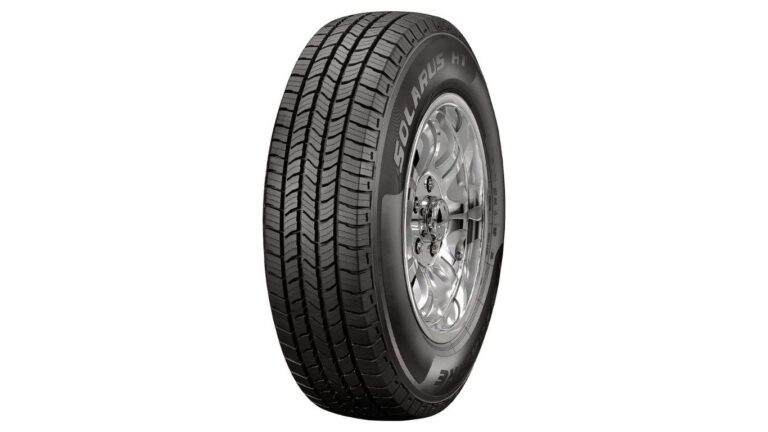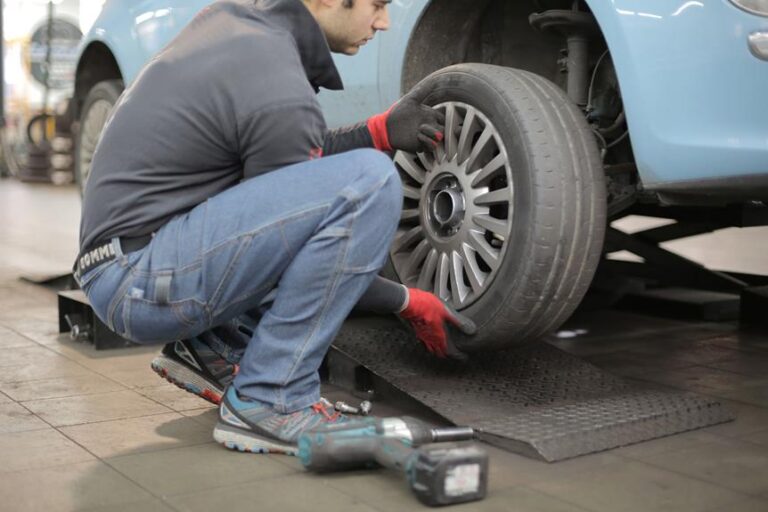Winter Tire Installation: A Step-by-Step Guide
In the realm of vehicular maintenance, the installation of winter tires stands as a crucial step towards ensuring optimal performance and safety during the frosty months. As the cold weather descends upon us, it becomes imperative to equip our vehicles with the necessary tools to navigate icy terrains.
This comprehensive guide aims to demystify the intricate process of winter tire installation, providing step-by-step instructions that are both technical and precise. Prepare to embark on a journey towards a safer and smoother winter driving experience.
Key Takeaways
- Regularly check tire pressure and ensure it is at the recommended level for improved handling and fuel efficiency.
- Inspect tires for damage and replace them if necessary to ensure adequate traction and safety.
- Gather all necessary tools before starting the installation process to ensure a smooth and efficient installation.
- Follow safety precautions and manufacturer's instructions for a safe and efficient winter tire installation.
Checking Tire Condition and Tread Depth
Regularly checking the tire condition and tread depth is crucial for maintaining optimal safety and performance.
One of the most important aspects of tire maintenance is checking tire pressure. Proper tire pressure ensures even tire wear, improved fuel efficiency, and enhanced handling and braking performance.
To check tire pressure, use a reliable tire pressure gauge and unscrew the valve cap on each tire. Press the gauge onto the valve stem and read the pressure indicated on the gauge. Compare this reading to the recommended pressure specified by the vehicle manufacturer, which can usually be found on a sticker inside the driver's door jamb or in the owner's manual. If the pressure is too low, add air until the desired pressure is reached, using an air compressor if necessary.
It is also crucial to inspect the tire condition and tread depth regularly. Look for any signs of damage, such as cuts, bulges, or punctures, and replace any tires that exhibit these issues. Additionally, ensure that the tread depth is sufficient to provide adequate traction. The minimum legal tread depth is typically 2/32 of an inch, but it is advisable to replace tires when the tread depth reaches 4/32 of an inch for improved safety and performance.
Gathering the Necessary Tools
Before beginning the winter tire installation process, it is crucial to gather the necessary tools. These tools include:
- Torque wrench
- Jack stands
- Rubber mallet
- Tire pressure gauge
- Lug nut wrench
Ensuring that you have all the required tools will facilitate a smooth and efficient installation process, while also guaranteeing your safety during the procedure.
Essential Tools for Installation
To ensure a seamless winter tire installation, it is imperative to procure the essential tools required for the task at hand. The following table highlights the recommended winter tire brands and their corresponding tire sizes:
| Winter Tire Brand | Recommended Tire Sizes |
|---|---|
| Michelin | 205/55R16 |
| Bridgestone | 225/50R17 |
| Continental | 215/60R16 |
These top-rated winter tire brands offer a range of sizes to fit various vehicles. It is crucial to select the correct tire size for your vehicle to ensure optimal performance and safety during winter driving conditions.
In addition to the winter tire brands mentioned above, other reputable brands such as Pirelli, Goodyear, and Dunlop also offer a wide selection of winter tires in various sizes. It is recommended to consult your vehicle's manual or a professional tire dealer to determine the appropriate tire size for your specific make and model.
Safety Precautions During Installation
Ensuring the safe installation of winter tires involves carefully gathering the necessary tools and following proper safety precautions.
Here are some essential steps to prevent accidents and avoid tire damage:
- Inspect the tires: Before installation, examine the winter tires for any signs of wear, cuts, or bulges. This will help identify potential issues that could lead to accidents or tire damage.
- Use the right tools: Ensure you have the appropriate tools, such as a jack, lug wrench, and torque wrench, to safely remove and install the tires. Using improper tools can cause accidents or damage to the tires.
- Follow the manufacturer's instructions: Each tire has specific installation guidelines provided by the manufacturer. Adhering to these instructions is vital to prevent accidents and ensure proper tire fitment.
- Securely fasten the tires: Tighten the lug nuts in a star pattern to distribute the pressure evenly. This prevents tire damage and ensures the tires are securely fastened to the vehicle.
By following these safety precautions, you can prevent accidents and avoid tire damage during the installation of winter tires.
Stay safe on the road this winter!
Tips for Efficient Installation
One crucial tip for efficient installation is to have all the required tools readily available, including a jack, lug wrench, and torque wrench. These tools are essential for a smooth and time-saving tire installation process. In addition to having the necessary tools, there are other efficient techniques and time-saving methods that can be employed. One such technique is to properly organize and lay out all the tires and tools before starting the installation process. This ensures that everything is easily accessible and minimizes the time spent searching for tools or tires. Another time-saving method is to use a power tool, such as an impact wrench, for removing and tightening the lug nuts. This significantly reduces the time and effort required compared to using a manual lug wrench. Lastly, using a tire mounting machine instead of manually mounting the tires can greatly speed up the installation process.
| Efficient Techniques | Time-Saving Methods |
|---|---|
| Organize tools and tires before starting | Use a power tool for lug nuts |
| Use a tire mounting machine |
Preparing the Vehicle for Tire Installation
The first step in preparing the vehicle for tire installation involves checking the vehicle's tire pressure using a pressure gauge. This is an important step to ensure that the tires are properly inflated and ready for installation.
Here are some other crucial steps to follow during the vehicle preparation process:
- Inspect the tires for any visible damage or signs of wear. Look for cuts, bulges, or uneven tread wear. It's important to address any issues before installing new tires to ensure optimal performance and safety.
- Clean the tires thoroughly before installation. Use a mild detergent and water to remove any dirt, grime, or brake dust from the surface of the tires. This will help improve the adhesion between the tires and the rims, ensuring a secure fit.
- Check the condition of the rims. Look for any signs of damage or corrosion. It's important to have clean and undamaged rims to ensure a proper seal between the tires and the rims.
- Finally, make sure to properly torque the lug nuts when installing the tires. This will help ensure that the tires are securely fastened to the vehicle, reducing the risk of accidents or tire failure.
Removing the Summer/All-Season Tires
To properly prepare for winter tire installation, it is important to remove the summer/all-season tires and replace them with appropriate winter tires. Before removing the tires, it is crucial to check the tire pressure to ensure optimal performance and safety. Adequate tire pressure not only improves traction on slippery surfaces but also enhances fuel efficiency.
Once the tire pressure has been checked, the next step is to remove the summer/all-season tires. Start by loosening the lug nuts using a lug wrench in a star pattern to avoid damaging the wheel studs. Once all the lug nuts are loosened, lift the vehicle using a jack and secure it with jack stands for added safety.
Now, remove the lug nuts completely and gently pull the tire off the wheel hub. Inspect the tires for any signs of wear and tear, such as uneven tread wear or cracks. This is also a good opportunity to rotate the tires, as recommended by the manufacturer. Regular tire rotation frequency extends the lifespan of the tires and ensures even wear on all four wheels.
With the summer/all-season tires removed, it is time to install the appropriate winter tires. Carefully align the tire with the wheel hub, ensuring that the lug nut holes are aligned. Secure the tire in place by hand-tightening the lug nuts in a star pattern. Once the lug nuts are hand-tightened, lower the vehicle and use a torque wrench to tighten the lug nuts to the manufacturer's recommended torque specification.
Properly Positioning the Winter Tires
When installing winter tires, it is essential to position them correctly on the wheel hub and secure them with lug nuts to ensure optimal traction and safety while driving in winter conditions. Proper positioning of winter tires involves aligning the tire's valve stem with the valve hole on the wheel to allow for easy access when inflating or deflating the tires. Additionally, ensuring that the tires are mounted evenly and snugly on the wheel hub helps to prevent vibrations and uneven wear.
To engage the audience, here are four important tips for properly positioning winter tires:
- Clean the wheel hub thoroughly before installing the winter tires to remove any dirt or debris that may hinder proper positioning.
- Use a torque wrench to tighten the lug nuts to the manufacturer's recommended torque specifications. This will ensure a secure fit and prevent the tires from becoming loose while driving.
- Rotate the tires regularly to promote even wear and extend their lifespan. This can be done every 5,000 to 8,000 miles or as recommended by the tire manufacturer.
- Store the winter tires properly during the off-season to maintain their performance and longevity. This includes storing them in a cool, dry place away from direct sunlight and chemicals.
Following these tips will not only optimize the performance of your winter tires but also contribute to their overall longevity and safety. Remember to prioritize proper tire storage and seasonal tire maintenance to maximize the benefits of your winter tires.
Mounting and Balancing the Winter Tires
Mounting and balancing the winter tires is a critical step in ensuring optimal performance and safety during winter driving conditions.
Proper mounting involves securely attaching the tires to the wheels, while balancing ensures an even distribution of weight to minimize vibrations and improve ride comfort.
Understanding the importance of tire alignment, the benefits of balancing, and the choice between DIY installation or seeking professional help will help drivers make informed decisions for their winter tire needs.
Tire Alignment Importance
Proper tire alignment is crucial for maximizing the performance and longevity of your winter tires. When your tires are properly aligned, they are angled correctly to make optimal contact with the road, ensuring even wear and reducing the risk of accidents.
Here are four essential benefits of tire alignment:
- Improved Handling: Proper alignment enhances your vehicle's stability and maneuverability, allowing for better control on icy or slippery surfaces.
- Increased Fuel Efficiency: Misaligned tires can cause unnecessary drag, leading to decreased fuel efficiency. By aligning your tires, you can save on fuel costs and reduce emissions.
- Extended Tire Life: Alignment prevents uneven tire wear, which can result in premature tire replacement. This not only saves you money but also contributes to a more sustainable approach to vehicle maintenance.
- Safer Driving: Accurate tire alignment enhances traction and reduces the risk of hydroplaning, making your winter driving experience safer and more enjoyable.
To achieve proper alignment, a professional technician will use advanced equipment to measure and adjust the angles of your tires, ensuring they meet the manufacturer's specifications. It is recommended to have your tires aligned at least once a year or whenever you install new tires.
Balancing for Smooth Ride
Achieving a smooth ride during winter driving conditions requires expert balancing of the winter tires, ensuring optimal weight distribution and reducing vibrations. Winter tires are designed to provide superior traction and grip on icy and snowy roads, but their effectiveness can be compromised if they are not properly balanced.
When installing winter tires, it is important to rotate them regularly to ensure even wear and maximize their lifespan. This involves moving the tires from one position to another on the vehicle to distribute the wear evenly.
Additionally, proper tire storage during the off-season is crucial to maintain their performance. Storing winter tires in a cool, dry place away from sunlight and chemicals will help prevent degradation and extend their lifespan.
DIY Vs Professional Installation
When it comes to the installation of winter tires, drivers should carefully consider the advantages and disadvantages of DIY versus professional installation in terms of both mounting and balancing.
While DIY installation may seem cost-effective, there are several advantages to opting for professional installation:
- Expertise: Professional installers have the knowledge and experience to ensure proper mounting and balancing, minimizing the risk of accidents or tire damage.
- Time-saving: Professional installation is typically quicker, allowing drivers to get back on the road faster.
- Specialized equipment: Professionals have access to specialized tools and equipment that ensure precise mounting and balancing.
- Warranty coverage: Many tire manufacturers require professional installation for their warranty to remain valid, providing peace of mind for drivers.
Although DIY installation may seem like a budget-friendly option, the advantages of professional installation outweigh the initial cost.
It is important for drivers to prioritize safety and performance when considering winter tire installation.
Ensuring Proper Tire Pressure and Torque
To ensure optimal safety and performance, it is crucial to carefully measure and adjust the tire's air pressure and torque, thereby minimizing the risk of tire failure or accidents. Proper tire pressure maintenance is essential for maintaining vehicle stability, fuel efficiency, and tire longevity. Tire pressure should be checked regularly, especially before long trips or during extreme weather conditions. Underinflated tires can cause increased rolling resistance, leading to decreased fuel efficiency and uneven tread wear. Conversely, overinflated tires can result in reduced traction and a harsher ride. It is important to refer to the vehicle manufacturer's recommendations for the correct tire pressure.
In addition to tire pressure maintenance, torque wrench calibration is equally important. A torque wrench is used to tighten lug nuts or bolts to the recommended specification. Over-tightening can cause damage to the wheel or stud, while under-tightening can lead to wheel loosening and potential accidents. Regular calibration of the torque wrench ensures accurate torque readings, providing consistent results. It is advisable to follow the manufacturer's instructions for calibration frequency and technique.
Frequently Asked Questions
How Often Should I Check the Condition and Tread Depth of My Winter Tires?
Regularly monitoring the condition and tread depth of winter tires is crucial for maintaining optimal tire pressure and traction. This practice ensures safety and enhances overall performance, especially in challenging winter driving conditions.
Can I Use the Same Tools for Winter Tire Installation as I Do for Summer/All-Season Tire Installation?
Winter tire installation requires specific tools designed for the process, such as a torque wrench, jack stands, and a lug wrench. These tools ensure proper installation and safety, and cannot be substituted with tools used for summer/all-season tire installation.
Is There a Specific Order in Which I Should Prepare My Vehicle for Winter Tire Installation?
When preparing a vehicle for winter tire installation, it is important to follow a specific order of preparation. This involves gathering the necessary equipment and ensuring that the vehicle is clean and in proper working condition.
What Is the Best Way to Store My Summer/All-Season Tires During the Winter?
When it comes to storing summer or all-season tires during the winter, there are several tire storage tips to keep in mind. Proper storage is essential for maintaining the integrity and performance of your tires during the off-season.
How Often Should I Check the Tire Pressure and Torque of My Winter Tires?
Regularly checking the tire pressure and torque of winter tires is crucial in maintaining proper tire performance and ensuring optimal safety on the road. Proper tire pressure is essential for traction, handling, and fuel efficiency.
Conclusion
In conclusion, winter tire installation is a crucial step in ensuring safe and reliable driving during the cold season.
By following the step-by-step guide and using the necessary tools, one can properly position and mount the winter tires, resulting in optimal performance.
Just as a sturdy foundation supports a towering structure, installing winter tires provides the necessary stability and grip to navigate icy roads, evoking a sense of confidence and peace of mind for drivers.







